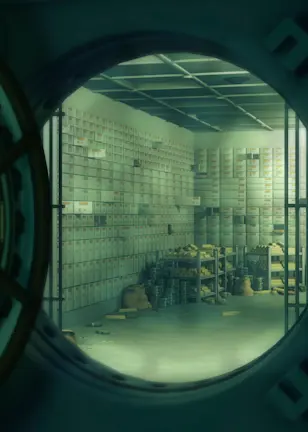With its seemingly infinite capacity to answer questions, create photorealistic images, and write computer code, generative AI has been heralded as the next era in technology, akin to the personal computer, the internet, and the smartphone. Indeed, AI has suddenly appeared in everything, everywhere, and all at once. Over the last two years, venture investment in generative AI rose 120% to USD 20.3 billion in 2023, the mention of AI during quarterly earnings calls within the S&P 500 nearly doubled and sales of technologies underpinning AI have risen three-fold. With that level of momentum, taking a critical view to separate the signal from the noise would also be prudent.
With AI expected to represent a multi-year opportunity, we have to take a step back to review the current state of the technology, outline our investment approach, and highlight the opportunities within enterprise software, cybersecurity, industry, robotics, and consumer technology.
Great expectations
In the 1960s, Stanford University professor Roy Amara noted that “we overestimate the impact of technology in the short term and underestimate the effect in the long run.” Expectations for AI do not appear muted. Goldman Sachs estimates that up to a quarter of all jobs in the US and Europe could be automated by AI, while PWC forecasts that AI will add USD 15.7 trillion to global GDP by 2030. Although the current set of companies with clearly measurable revenues derived directly from AI is small, more than a third of companies in the S&P 500 discussed AI on earnings calls during 2023.
Figure 1: Mentions of AI within S&P 500 members’ earnings calls
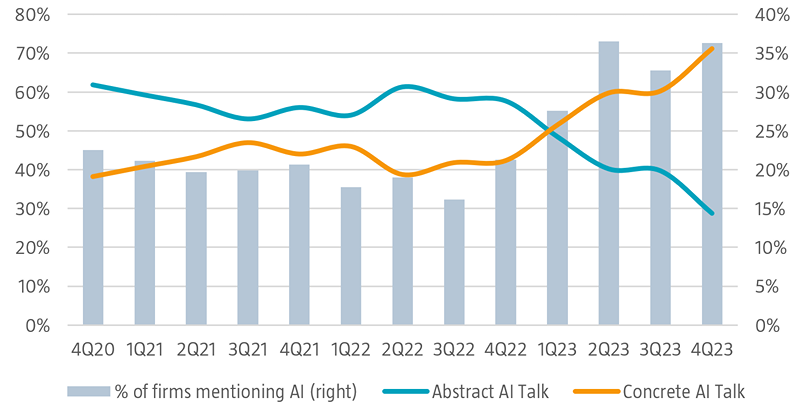
Source: Robeco, FactSet, March 2024.
Our approach
In previous technology eras, a handful of firms providing foundational intellectual capital captured the majority of the value creation across the cycle. For instance, this was the case for IBM in the mainframe era, Microsoft and Intel in the PC era, Apple and Qualcomm in the mobile era, and Amazon and Google in the internet era. In the case of artificial intelligence, chipmaker Nvidia has positioned itself as the effective standard for developers by pairing its ultra-fast parallel processing technology with their widely adopted software platform, CUDA.
While the impacts of structural changes and transformative shifts are broadly felt, there are typically few beneficiaries. According to a study by Hendrik Bessembinder from Arizona State University, when examining the returns of 64,000 global stocks, the top performing 2.4% of companies accounted for 100% of the USD 75.7 trillion in wealth creation between 1990 and 2020. 1
Figure 2: Distribution of US equity market returns between 1973 and 2020
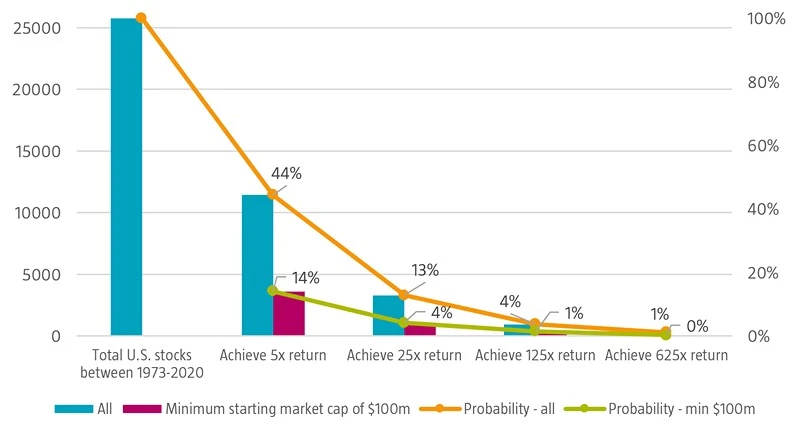
Source: H. Bessembinder, Arizona State University, 2021.
That being said, similar to the internet and enterprise software, artificial intelligence is not a singular technology, there are many forms of AI. For instance, as Software as a Service (SaaS) models developed, several dominant platforms emerged focused on specific functions like Salesforce.com in customer relationship management, ServiceNow for IT support, and Workday for human resources. The emergence of AI may serve to strengthen those services, or facilitate new entrants. Moreover, while much of the focus today centers on generative AI, applied AI and machine learning, other tools continue to evolve in applications across automation, cybersecurity, logistics, and robotics. As a result, there exists broad potential for multiple profitably scaled businesses to emerge from the new wave of AI development.
Industrial AI
While consumer applications like chatbots and image generators have garnered the most attention recently, AI has been at the center of industrial strategy for more than a decade. By augmenting robotics and other infrastructure with sensors connected by networks to software, the Internet of Things (IoT) is already having a material impact on operations and margins. For example, working with Microsoft, BMW deployed an IoT system that the automaker credited with reducing one factory’s metal-press shop downtime by 25%.
Figure 3: Industry 4.0 combines sensors, data, cloud computing, robotics, and artificial intelligence to form smart manufacturing
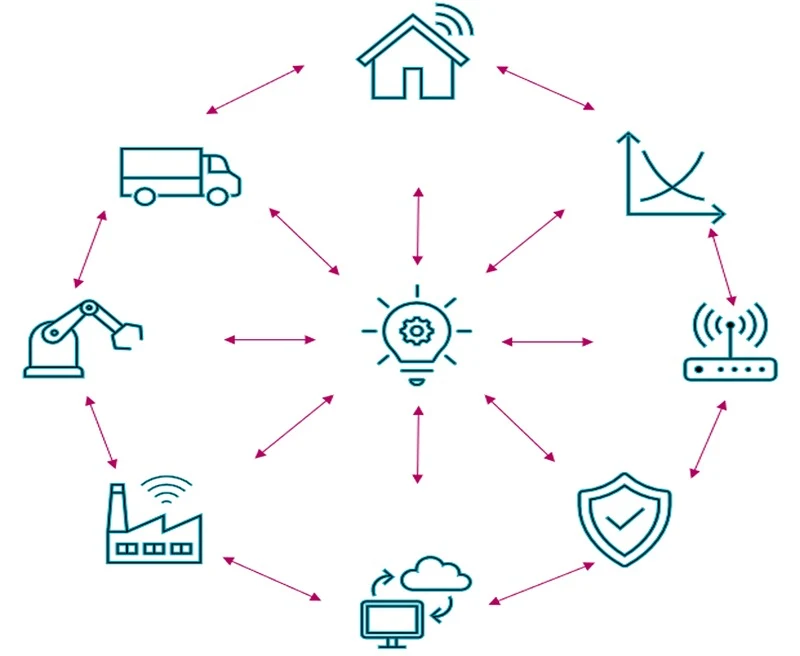
Source: Robeco.
Robotics
By learning from human controls and taking input from sensors and cameras, robotic production is poised to become more efficient and more flexible. For instance, Google DeepMind’s RT-2 AI model was trained on both robotic-specific data as well as from the web to enable machine vision equipped robots to perform tasks that were not preprogrammed.
Figure 4: Google DeepMind robotic arm performs tasks not contained in pre-defined instructions
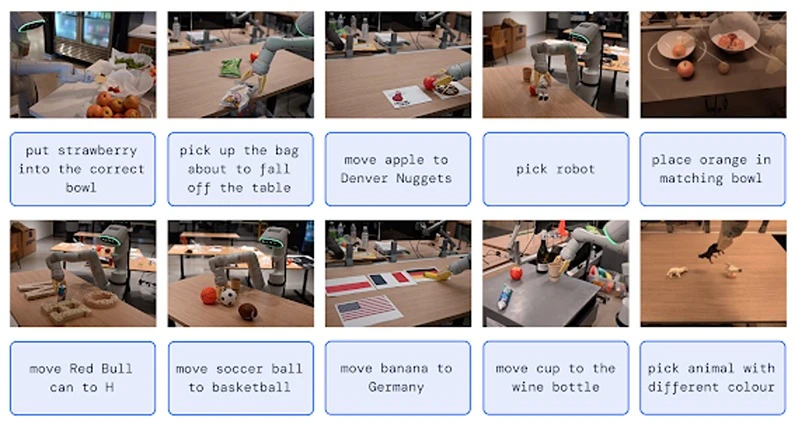
Source: Google DeepMind.
Enterprise AI
Combining advanced analytics with generative AI’s capacity to put trends into words, the promise of big data could be realized. Indeed, companies are already integrating AI technologies to automate workflows, improve customer service, and bolster cybersecurity measures.
Software
AI also presents a significant opportunity for the software industry to enhance existing applications, create new applications not previously feasible, and to improve the productivity of software developers. Research firm Gartner estimates that AI accounted for 8% of software revenues in 2023, a figure the firm expects to reach 35% by 2027.
Cybersecurity
Developments in the field of AI offers security professionals new tools to combat increasingly sophisticated cyberattacks. Today’s cyber protection systems employ machine learning and behavioral analysis to detect threats based upon actions rather than signatures alone. Beyond just detecting threats, generative AI also offers the potential to automate the response to the continuous stream of attacks.
At home
With its ease of use and its ability to answer a seemingly infinite range of questions, the launch of ChatGPT has sparked consumer imaginations. According to Pew Research, as of the first quarter of 2024, 23% of US adults have used the service. But the nascent tech isn’t really entirely new, as AI and machine learning have long been correcting spelling errors, enabling secure biometric mobile payments, and more recently making content recommendations on Netflix and TikTok.
Figure 5: US ChatGPT use by age
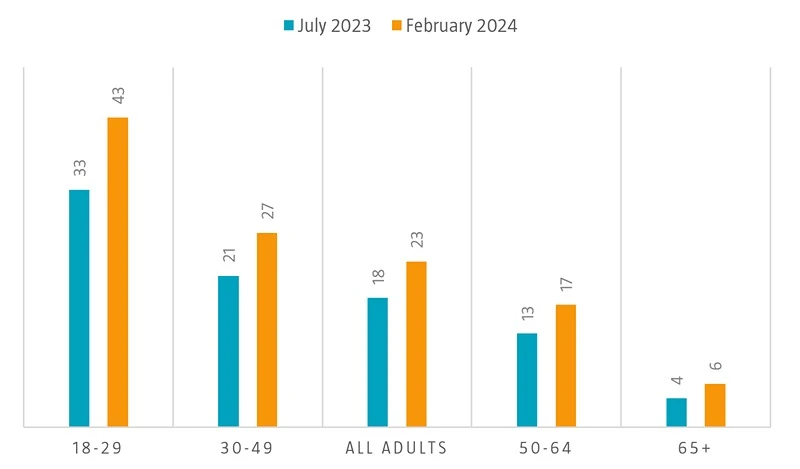
Source: Pew Research Center, March 2024.
On the road
Although widescale deployment of autonomous vehicle transportation may still be years away, AI-assisted features like lane-departure corrections and automatic braking are having a material positive impact on safety. For instance, according to Tesla’s 2023 annual impact report, Tesla vehicles with autopilot engaged were involved in 88% fewer accidents per million highway miles driven than the US average.
Digital innovations
At school
While concerns students hand their homework to ChatGPT to complete are not unfounded, the technology is proving useful. For instance, at the University of Texas, history professor Steven Mintz asks his students to use ChatGPT to help write essays while requiring they annotate the process, including listing prompts used, corrections made, and source material referenced. In addition, the free education non-profit Kahn Academy is leveraging AI to create personalized tutors that will learn the strengths and weaknesses of each student to help focus learning.
In healthcare
With more than USD 4.5 trillion spent annually on healthcare in the US alone, even marginal improvements derived from AI could have an enormous impact. AI is increasingly applied in radiology to enhance image segmentation, computer-aided diagnosis, and predictive analytics. Most notably, AI is greatly accelerating the pace of advanced medical research and assisting the drug discovery process. In 2022, Google DeepMind AlphaFold accurately predicted the 3D structures of every known protein (roughly 200 million) to within the width of an atom.
AI risks and concerns
The outlook for AI spans a near infinite range from eternal prosperity to great peril. On the one hand, PWC forecasts that AI could add USD 15.7 trillion to the global economy by 2030. On the other, however, several leaders in the field including Open AI CEO Sam Altman have noted the technology poses an existential risk to humanity. While extinction may seem like a stretch, it is not difficult to find examples of AI software deviating from its intended use.
For example, while generative AI systems have become remarkably adept at producing coherent answers to an ever widening array of topics, they are also very often wrong. In one of the more notable errors from last year, ChatGPT provided multiple detailed yet non-existent case law precedents and judicial findings that lawyers submitted to a US federal court.
As has been the case with previous automation technology cycles, many have expressed concern that AI will take job opportunities from humans. However, this is not necessarily true, as for example demand for accountants continued to expand with the advent of calculators, spreadsheets, and software. As MIT economist David Autor found, “Sixty percent of workers today are employed in occupations that did not exist in 1940, implying that over 85 percent of employment growth over the last 80 years is explained by the technology-driven creation of new positions.”2
AI is also seen as a potential contributor to global warming, with the International Energy Agency forecasting the technology will lead to a 73% jump in data center energy demand. However, efficiency gains may greatly limit the impact. As a study by Ericsson and the International Telecommunications Union found, the technology and communications share of global energy use remained stable at 4% between 2007 and 2020, while the amount of data traffic rose 40-fold.3
Figure 6: Technology sector electricity usage, terawatt-hours (TWh)D
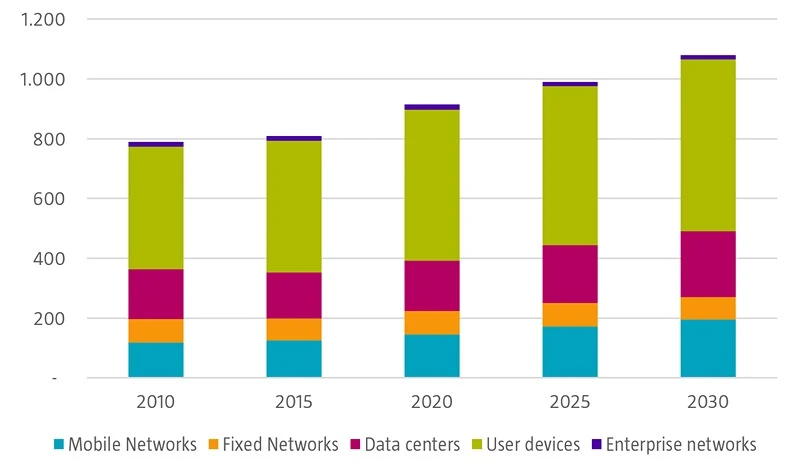
Source: Ericsson, International Telecommunications Union, 2023.
The early approach to internet regulation, based on principles such as net neutrality, self-regulation, and the safe harbor doctrine, was seen as a way to foster growth and innovation of the technology. However, this laissez-faire approach also created opportunities and incentives for bad actors to exploit the internet. Cybercrime, fraud, and social media manipulation have resulted in direct theft, business interruptions, privacy violations, and election interference. The more recent policy response to technology – including issuing billions in fines, the EU’s General Data Protection Regulation, and an acceleration of antitrust investigations on multiple continents – suggests regulators are likely to police AI more strictly than the internet.
Conclusion
Artificial intelligence is intertwined with every trend we follow in the Robeco Digital Innovations strategy. In our Robotics & Automation trend, AI and machine learning have long been hard at work improving efficiency and reducing waste. Production bottlenecks, labor shortages, and geopolitical security considerations have driven renewed interest in reshoring manufacturing, where AI, robotics and automation will play an expanding role.
Beyond manufacturing, from agriculture to logistics and transportation, nearly every sector of the economy is in some stage of a digital transformation. Our Digital Enablers trend is benefiting directly, with enterprise spending on software expanding at a 9.6% compound annual growth rate in the past five years. The improving scope and capability of AI is likely to drive an acceleration in software investment, particularly for cloud computing, a segment which is already expanding at a 26.7% CAGR.
In our Secure Digital Infrastructure trend, expenditure on IT security is expanding rapidly as traditional threats mutate and the potential attack surface widens. AI is positioned to better detect threats and automate responses. Moreover, the intensive computational requirements of AI is also driving accelerated investments in the underlying infrastructure where hyperscale cloud networks are taking share from traditional on-premise enterprise solutions.
In constructing a relatively concentrated portfolio, we seek to identify innovative, quality companies holding or building leadership positions in their respective domains, and we focus on those delivering consistent profitable growth. We believe this investment approach is capturing the companies that are benefiting from direct investment in AI, and those that are leveraging AI most effectively in the real economy.
Footnotes
1 See Bessembinder et al: Long-Term Shareholder Returns: Evidence from 64,000 Global Stocks (2023).
2 The labor market impacts of technological change, D. Autor, NBER July 2022
3 ICT sector electricity consumption and greenhouse gas emissions – 2020 outcome; February 2024, J. Malmodin, N. Lovehagen.
Get the latest insights
Subscribe to our newsletter for investment updates and expert analysis.
Important information
This information is for informational purposes only and should not be construed as an offer to sell or an invitation to buy any securities or products, nor as investment advice or recommendation. The contents of this document have not been reviewed by the Monetary Authority of Singapore (“MAS”). Robeco Singapore Private Limited holds a capital markets services license for fund management issued by the MAS and is subject to certain clientele restrictions under such license. An investment will involve a high degree of risk, and you should consider carefully whether an investment is suitable for you.













